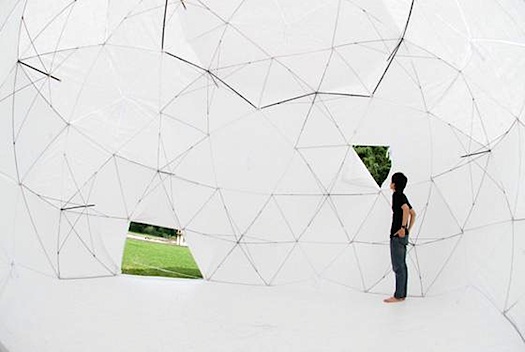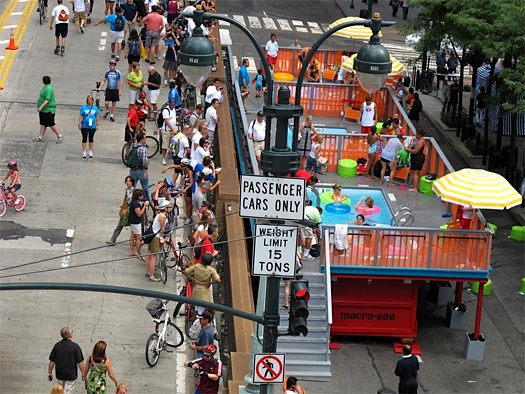
The Interventionist’s Toolkit, Mimi Zeiger’s long and illuminating essay in Design Observer, tracks the effect the recession has had on inspiring frugal, improvisational strategies for urban spaces around the world. When there’s no money for traditional architecture projects,” Provisional, Opportunistic, Ubiquitous, and Odd Tactics in Guerilla and DIY Practice and Urbanism” take root. We’ve excerpted the sections of Zeiger’s piece that are chock full of examples, with links to explore.
“These days vacant lots offer sites for urban farming, mini-golf, and dumpster pools. Trash recycles into a speculative housing prototype (see the Tiny Pallet House). Whether it’s The Living’s Amphibious Architecture or Mark Shepard’s Serendipitor, the built environment speaks through mobile devices. Retail spaces hit by the recession are fodder for reinvention, as the art organization No Longer Empty transforms unleased storefronts into temporary galleries. Even the street itself is reclaimed. REBAR’s annual initiative, Park(ing) Day, urges global participants to use a pranksters wit to turn parking spaces into pocket parks, one quarter at a time. (If you don’t feel like reading much, just click on the links, or scroll down for our favorites…)
…A critical mass of projects was identified in late 2008 when the Canadian Centre for Architecture’s director, Mirko Zardini, and curator for contemporary architecture, Giovanna Borasi, selected 99 works for Actions: What You Can Do With the City. The design concepts, research and operational tactics spotlighted in the exhibition and related catalogue drew heavily on guerrilla art. Projects such as the N55 PROTEST Rocket, a militarized take on gardening that rocket-launches “seed bombs,” which explode in empty lots releasing “Superweed” seeds; the illicit Operation: Ivy League, created by the self-proclaimed anarchitects The Space Hijackers, who installed ivy on sites around central London as a protest against corporate architecture; or Sit In, a series of public benches deployed around Toxteth, Liverpool: all these function within a reactive, if not revolutionary, framework. As Zardini says in the press release: “They reveal the existence of a world rich in inventiveness and imagination, alien to our contemporary modes of consumption. These actions propose alternative lifestyles, reinvent our daily lives, and reoccupy urban space with new uses.”
We especially like Tools for Actions: What You Can Do With the City, with its 99 actionsthat instigate positive change in contemporary cities around the world…like an Umbrella Shelter and ….and dumpster diving/swimming pools…

…

and Fergus the Forager…



